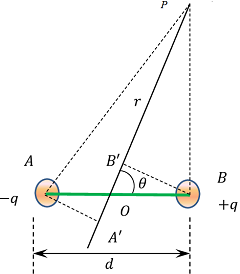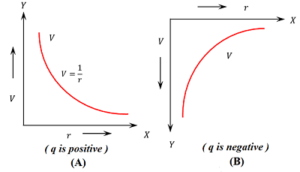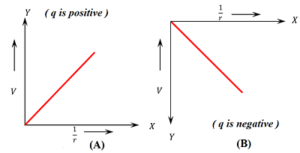What is the Electric Potential of a Dipole?
Electric potential of dipole at a point in the electric field produced by dipole is defined as the work done by an external force in bringing a test charge from infinity to that point.
Consider about a dipole AB as shown in figure. Let, –
- End charges of dipole are ( - q ) \ \text {and} \ ( + q ) .
- Distance of separation between the charges is d .
- O is the mid point of dipole length i.e. ( d = AB )
Consider about a point P , where ( OP = r ) and ( \angle {POB} = \theta ) .
Assume that ( r >> d ) .
Let, AA' is a perpendicular to PO drawn from point A and BB' is another perpendicular drawn from B .
Therefore, \quad AP = A'P = ( OP + OA' ) = ( OP + AO \cos \theta ) = ( r + \frac {d}{2} \cos \theta )
Similarly, \quad BP = B'P = ( OP - OB' ) = ( r - \frac {d}{2} \cos \theta )
Potential at P due to the charge ( - q ) is –
V_1 = - \left ( \frac {1}{4 \pi \epsilon_0} \right ) \left ( \frac {q}{AP} \right )
= - \left ( \frac {1}{4 \pi \epsilon_0} \right ) \left ( \frac {q}{r + \frac {d}{2} \cos \theta} \right )
Potential at P due to the charge ( + q ) is –
V_2 = \left ( \frac {1}{4 \pi \epsilon_0} \right ) \left ( \frac {q}{BP} \right )
= \left ( \frac {1}{4 \pi \epsilon_0} \right ) \left ( \frac {q}{r - \frac {d}{2} \cos \theta} \right )

Therefore, net potential at P , due to the dipole is –
V = ( V_1 + V_2 )
= - \left ( \frac {1}{4 \pi \epsilon_0} \right ) \left ( \frac {q}{r + \frac {d}{2} \cos \theta} \right ) + \left ( \frac {1}{4 \pi \epsilon_0} \right ) \left ( \frac {q}{r - \frac {d}{2} \cos \theta} \right )
= \left ( \frac {1}{4 \pi \epsilon_0} \right ) \left [ \left ( \frac {q}{r - \frac {d}{2} \cos \theta} \right ) - \left ( \frac {q}{r + \frac {d}{2} \cos \theta} \right ) \right ]
= \left ( \frac {1}{4 \pi \epsilon_0} \right ) \left [ \frac {q d \cos \theta}{r^2 - \frac {d^2}{4} \cos^2 \theta} \right ]
= \left ( \frac {1}{4 \pi \epsilon_0} \right ) \left [ \frac {q d \cos \theta}{r^2} \right ] . Neglecting the term \left [ \frac {d^2}{4} \cos^2 \theta \right ] being very small.
So, \quad V = \left ( \frac {1}{4 \pi \epsilon_0} \right ) \left [ \frac {p \cos \theta}{r^2} \right ]
Electric Potential of a Point Charge
Consider about a point charge ( q ) as shown in figure. Let, P is a point at a distance ( x ) from the charge.
A unit positive charge ( + 1 ) is placed at P in the electric field produced by the charge ( q ) . The electrostatic force of repulsion between the charge ( q ) and charge ( + 1 ) , will be –
F = \left ( \frac {1}{4 \pi \epsilon_0} \right ) \left ( \frac {q}{x^2} \right )
= \left ( \frac {q}{4 \pi \epsilon_0 x^2} \right )
Direction of force ( \vec {F} ) is just opposite to the direction of electric field ( \vec {E} )

Now, let the charge ( + 1 ) is displaced by a small distance ( dx ) towards the charge ( q ) without producing any acceleration.
Small work done in displacing the charge will be –
dW = \vec {F} . d \vec {x}
= F . dx \cos 180 \degree = - F dx
= - \left ( \frac {q}{4 \pi \epsilon_0 x^2} \right ) dx …….. (1)
Therefore, total work done in displacing the charge from infinity to point A , will be –
\int {dW} = \int\limits_{\infty}^{r} - \left ( \frac {q}{4 \pi \epsilon_0 x^2} \right ) dx
Or, \quad W = - \left ( \frac {q}{4 \pi \epsilon_0} \right ) \int\limits_{\infty}^{ r} x^{(- 2)} dx
= - \left ( \frac {q}{4 \pi \epsilon_0} \right ) \left [ \frac {x^{- 1}}{- 1} \right ]_{\infty}^{r}
= \left ( \frac {q}{4 \pi \epsilon_0} \right ) \left [ \frac {1}{x} \right ]_{\infty}^{r}
= \left ( \frac {q}{4 \pi \epsilon_0} \right ) \left [ \frac {1}{r} - \frac {1}{\infty} \right ]
= \left ( \frac {1}{4 \pi \epsilon_0} \right ) \left ( \frac {q}{r} \right )
Because, \quad \left ( \frac {1}{\infty} \right ) = 0
But, work done in bringing a unit positive charge from infinity to a given point = Electric potential due to the source charge at that point.
Therefore, electric potential at a point at distance ( r ) from a point charge will be –
V_{r} = \left ( \frac {1}{4 \pi \epsilon_0} \right ) \left ( \frac {q}{r} \right )
- If the source charge is a positive i.e. ( + q ) , then electric potential ( V_{r} ) is positive.
- If the source charge is negative i.e. ( - q ) , then electric potential ( V_{r} ) is negative.
Variation of Potential with distance
A figure is drawn to illustrate the variation of electric potential at a point with respect to its distance from the source point charge. Two graphs are most important.
- Graph of potential versus distance.
- Graph of potential versus reciprocal of distance.
Graph of potential versus distance
- Variation of electric potential ( V ) at a point with respect to its distance ( r ) from a positive source charge is shown in figure (A).
- Variation of electric potential ( V ) at a point with respect to its distance ( r ) from a negative source charge is shown in figure (B).
The graph is having following properties.
- It is a curve.
- Potential is decreasing exponentially with increase in distance ( r )

Graph of V versus \left ( \frac {1}{r} \right )
- Variation of electric potential V at a point with respect to its reciprocal of distance \left ( \frac {1}{r} \right ) from a positive point source charge is shown in figure (A).
- Variation of electric potential V at a point with respect to its reciprocal of distance \left ( \frac {1}{r} \right ) from a negative point source charge is shown in figure (B).
The graph has following properties.
- It is a curve.
- Potential is increasing linearly with increase in reciprocal of distance \left ( \frac {1}{r} \right ) .

